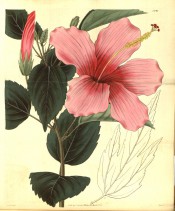Hibiscus liliiflorus-rosa-sinensis [Bidwill]
A hybrid of Hibiscus liliiflorus Cav. x H. rosa-sinensis L. ‘Sometimes the shape of the leaves is almost exactly as in H. Rosa-sinensis: at other times, and that very frequently, they are trifid, or tripartite, with the segments laciniated. The flowers are deep red, buff-coloured, and more frequently of a bright and delicate rose colour.’ [BM t.2891/1829]. The figure is of the hybrid Hibiscus liliiflorus x H. rosa-sinensis shown in Curtis’s Botanical Magazine, but to what extent it resembles Bidwill’s hybrid is impossible to say.
Horticultural & Botanical History
‘A mule plant, derived from H. liliiflorus, whose flowers were fertilised by the pollen of H. Rosa-sinensis. The consequence is a production, very variable, indeed, as to size and form of both flowers and leaves, and amply deserving a place in every collection of stove plants. The first I heard of this charming plant was from my often-mentioned friend and invaluable correspondent, Charles Telfair, Esq. of the Mauritius, to whom I am indebted for two beautiful drawings, from the pencil of Mrs. Telfair; from one of which, the engraving here given is made. These drawings were accompanied by a letter, with the following remarks-upon them. “We think a sight of these drawings may induce our excellent friend Mr. Barclay to endeavour to cultivate and vary this beautiful shrub. The variety to be artificially produced is endless, especially in the colour:-the size of the flowers too is very great, and their brilliancy and delicate shading render them objects of great interest to cultivators. With us it grows almost to a tree: and the blossoms are upon it nearly at all seasons of the year.” Plants were at the same time sent to Mr. Barclay at Bury Hill, who cultivates them most successfully, and has favoured me both with drawings and dried specimens. Sometimes the shape of the leaves is almost exactly as in H. Rosa-sinensis: at other times, and that very frequently, they are trifid, or tripartite, with the segments laciniated. The flowers are deep red, buff-coloured, and more frequently of a bright and delicate rose colour.’ [BM t.2891/1829].
History at Camden Park
Macarthur sent a plant to John Lindley, writing on 15th February 1848: ‘The hybrid Hibiscus is of great beauty. It was raised by Mr. Bidwill between H. lilieflorus and the Tahitian variety of rosa sinensis, itself perhaps a new species.’ [MP A2933-1, p.157]. A plant was presented to the Sydney Botanic Garden by William Macarthur on September 15th 1847 [RBGS AB]. This record states clearly that the plant was from Tahiti. A second plant of this cross was also presented at the same time, the record endorsed ‘different variety’ suggesting significant differences between plants from the cross, as noted in Curtis’s Botanical Magazine.
Notes
Published Jan 11, 2010 - 03:19 PM | Last updated Jan 11, 2010 - 03:33 PM
| Family | Malvaceae |
|---|---|
| Category | |
| Region of origin | Garden origin, Tahiti |
| Synonyms | |
| Common Name | |
| Name in the Camden Park Record | Hibiscus hybrid |
| Confidence level | medium |


